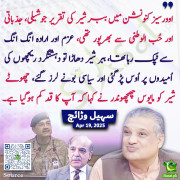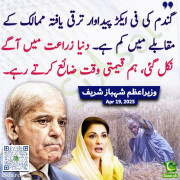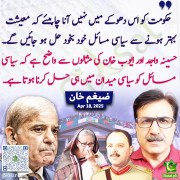M Ali Khan
Minister (2k+ posts)
The Rise and Fall of Hezbollah
The group falsely believed its domination of Lebanese politics was permanent.By Hilal Khashan - Geopolitical Futures - October 15, 2024
The rise of Hezbollah began in the early 1980s. Following the success of the 1979 Iranian Revolution, Ayatollah Ruhollah Khomeini sought to export the ideology of the revolution throughout the Arab region. During the Israeli invasion of Lebanon, he saw an opportunity to expel the Palestine Liberation Organization from its bastion in the country. He sent a small contingent of troops from the Islamic Revolutionary Guard Corps to Lebanon to spread his revolutionary principles. Hezbollah attributed its success to the vision of its organized and unpretentious leaders, who came from impoverished socio-economic backgrounds. Its efficient and personal way of communicating with its Shiite support base also aided its rise as Lebanon’s unrivaled political and military organization.
But its emergence on the political scene put it on a collision course with another Shiite political force: the Amal Movement. Founded by Musa al-Sadr and backed by Syrian President Hafez Assad, the group evolved as the armed wing of the Movement of the Dispossessed, which was established in 1974 on the eve of the Lebanese Civil War. Hezbollah and the Amal Movement fought for two years beginning in 1988 in what came to be known as the Fraternal War. It ended in 1990 with the signing of the Damascus Agreement, effectively placing Amal under Hezbollah’s wing.
This arrangement aided Hezbollah’s growth and appealed to a broad sectarian constituency that was oppressed for a millennium by Sunni-dominated imperial states. For centuries, Shiites had searched for a heroic leadership to redeem them. However, Hezbollah leader Hassan Nasrallah, who was assassinated by Israel last month, adopted a propagandistic political posture that exaggerated the party’s military resources and grossly downplayed Israeli capabilities. The party failed to understand how sectarian power-sharing works in Lebanon. It also failed to make strategic concessions that could have prevented its own demise.
Charismatic Leader
Once in Lebanon, IRGC forces headed to the city of Baalbek in the northern Bekaa Valley, where they proselytized a Shiite cadre to follow Khomeini’s rule as the jurisconsult, or supreme religious leader. Khomeini argued that this interim arrangement, which did not have a specified end time, was a prerequisite for the return of Muhammad al-Mahdi, the twelfth Shiite Imam who went into occultation in 874 and was expected to return to defeat evil and lead humanity to salvation.
Hezbollah mastered the art of martyrdom and turned it into a highly effective weapon through which it gained popularity and credibility. The death of one of Nasrallah’s sons in a confrontation with the Israeli army in 1997 dramatically increased Nasrallah’s popularity because no Arab leader had ever before sent his children to the frontlines to fight against Israel.
Nasrallah always said that a fighter’s strength was determined not by the type of weapon he carried but rather by his will and willingness to die. Hezbollah considered the pursuit of martyrdom without hesitation to be the key to its victories and what distinguished it from Israeli soldiers who did not want to die in war. Nasrallah presented himself as a man on a mission to transform Lebanon into an Islamic state following the Iranian model and further its regional pursuits as a religious duty. His charisma and religious zeal and the promise of better days ahead appealed to Shiites, who cherished his forceful and convincing political rhetoric.
Propaganda Obscured Israel’s Resolve
Successive victories against Arab armies since 1948 had given Israel an aura of invincibility. But its decision to withdraw from southern Lebanon in 2000 gave Arabs the impression that Hezbollah finally succeeded in doing what no other Arab army managed do before. Nasrallah declared that Israel was “weaker than a spider’s web.”
In 2006, war broke out when Hezbollah, facing steady pressure from other Lebanese groups to disarm, launched a cross-border raid, capturing three Israeli soldiers. To prove the worth of its military wing, Hezbollah hoped to swap them with Lebanese prisoners in Israel. Israel had no interest in going to war against Hezbollah, but the death of 13 soldiers in the raid compelled Israeli Prime Minister Ehud Olmert to action, which inflicted a heavy toll on Hezbollah and displaced hundreds of thousands of Shiites. Nasrallah appealed to then Prime Minister Fouad Seniora to convince the U.S. to back a cease-fire. Washington supported the issuance of U.N. Security Council resolution 1701, which demanded Hezbollah’s evacuation from the border area to north of the Litani River. When the war ended, Nasrallah called it a “divine victory.”
In 2022, Nasrallah threatened Israel with harsh retaliation if it assassinated Hamas or Islamic Jihad officials on Lebanese territory. However, his response to the assassination of a senior Hamas official in the southern suburbs of Beirut early this year was superficial, consisting of a few Katyusha rockets, most of which the Iron Dome intercepted. Nasrallah expressed Hezbollah’s approval of any agreement between Lebanon and Israel to delimit the borders of their respective economic zones. After a deal was concluded in 2022, Nasrallah said he agreed with the Lebanese government’s compromise – but not before he threatened to prevent Israel from exploiting the Karish gas field if Lebanon did not get a fair deal.
Nasrallah declared that Israel wanted to avoid a war because of Hezbollah’s military strength, especially its missiles, which are capable of hitting targets anywhere in Israel, including the Dimona nuclear facility in the Negev desert and the city of Eilat on the Gulf of Aqaba. Hezbollah officials claimed that Israel was unprepared to deal with the massive human and material toll its advanced weapons would inflict.
Hezbollah misunderstood the social implications of the massive demonstrations in 2023 throughout Israel against the government’s planned judicial reforms. In addition to the protests, several thousand reserve soldiers announced their abstention from military service in protest against the proposal, which would have reduced the powers of Israel’s Supreme Court. Nasrallah misread the warnings of senior Israeli military personnel (including the army chief of staff) about the dangers of approving these amendments for the army’s combat readiness and the fabric of Israeli society.
In his eulogy for Hezbollah’s chief of staff, who was killed by Israel in July, Nasrallah warned that the party would fight without restraint if a widespread war with Israel broke out. However, even after his assassination last month, this threat rang hollow. Israel has said the group has lost more than two-thirds of its missile arsenal, which Lebanese media claimed in recent years totaled 200,000 missiles. (Hezbollah has launched up to 10,000 rockets against Israel to support Gaza since the war there began more than a year ago.)
Neglecting Lebanon’s history
Hezbollah considered its domination of Lebanon permanent and belittled the country’s rich history. Just north of Beirut, the stelae of Nahr al-Kalb documents Lebanon’s deep history with 22 inscriptions outlining foreign armies’ conquests of the country, starting with Ramses II’s military campaign in the 13th century B.C. In 2000, Hezbollah intruded on the stelae by placing an inscription marking Israel’s voluntary withdrawal from southern Lebanon as a liberation, as if it represented the final cycle of Lebanese history.
When France granted Lebanon independence in 1943, the leaders of this religiously heterogeneous country created a confessional political system predicated on a delicate sectarian balance. Civil war broke out in 1958 mainly because President Camille Chamoun allied himself with the Hashemites in Iraq and Jordan and supported the British-sponsored Baghdad Pact, which was vehemently opposed by the popular Egyptian President Gamal Abdel Nasser.
The unconditional approval of Muslims of the Palestine Liberation Organization’s military presence in Lebanon placed the country on a collision course as Christians viewed the arrangement as an infringement on Lebanon’s sovereignty and destructive to its sectarian balance. This eventually led the country to a 19-year civil war, which resulted in hundreds of thousands of casualties and the destruction of the Lebanese economy.
Hezbollah took shape between 1982 and 1985, during Israel’s occupation of southern Lebanon. It thought that resistance to the occupation, penetration of Lebanese politics, and the ideological and material sponsorship of the Iranian Revolution would ensure not only its survival but also its permanence in and domination of Lebanese politics.
Hezbollah failed to appreciate that popular movements cannot last indefinitely in Lebanon’s political system. The assassination of towering Lebanese Prime Minister Riad al-Solh in 1951 eroded the balance of power between Christians and Muslims, encouraging Chamoun to promote regional policies unpopular among Lebanese Sunnis and effectively facilitating the 1958 civil war. The assassination of charismatic President-elect Bashir Gemayel in 1982 delivered a severe blow to the Christian Lebanese Forces, effectively shelving its political project.
In 2005, Hezbollah killed Prime Minister Rafik Hariri, ending his post-war reconstruction efforts. It became unavoidable that Israel would deliver the coup de grace to neutralize Hezbollah after its devastating military setbacks. The party’s survival hinged on Nasrallah as its central public figure. Killing him would drive a wedge between Hezbollah – whose poor military performance stunned Shiites – and its base of popular support.
Negotiations Closed
The U.S. president’s special envoy to Lebanon, Amos Hochstein, paid five visits to Lebanon to try to prevent war with Israel, focusing on the need for Hezbollah to delink itself from the Gaza conflict, implement Security Council resolution 1701, and withdraw to six miles north of the border with Israel. Hezbollah refused to comply with these conditions. Even the pro-Hezbollah Beirut newspaper al-Akhbar indicated in a front-page story its opposition to Hochstein’s plan, describing him as an Israeli mediator. This prompted the Biden administration to inform the Lebanese government shortly before Israel assassinated Nasrallah that the door to negotiations was closed. Israel promptly launched a massive air campaign ahead of a major ground offensive to drive Hezbollah away from the south, creating an unprecedented internal displacement, which the government in Beirut is ill-equipped to handle.
After Israel’s success in eliminating Hezbollah’s military and political leadership, Nasrallah’s deputy, Naim Qassem, informed Lebanese Prime Minister Najib Mikati of the party’s readiness to withdraw to north of the Litani River. He also authorized the head of the Amal Movement, Nabih Berri, who has been parliamentary speaker since 1992, to negotiate arrangements on behalf of Hezbollah to stop the war, paving the way for placing the party under the mantle of the Amal Movement, which would be a major shift in the balance of power among the Shiites of Lebanon.

The Rise and Fall of Hezbollah - Geopolitical Futures
The rise of Hezbollah began in the early 1980s. Following the success of the 1979 Iranian Revolution, Ayatollah Ruhollah Khomeini sought to export the


































